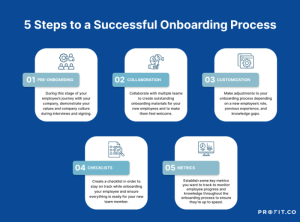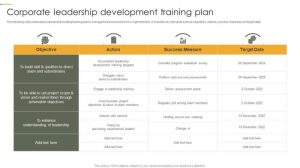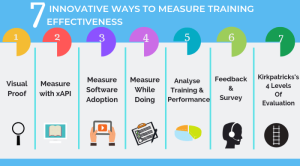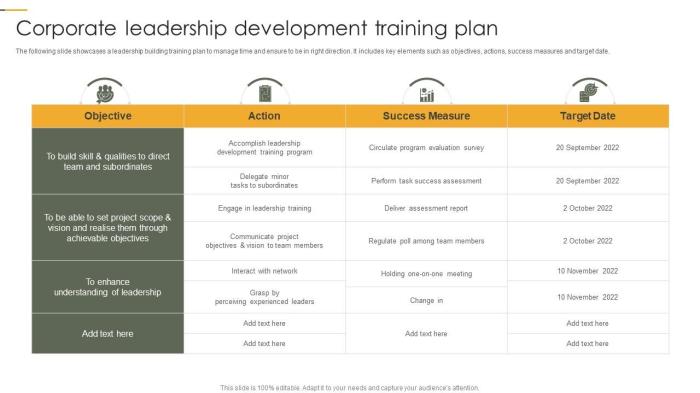
Effective corporate leadership development training is crucial for organizational success. It equips individuals with the skills and knowledge to navigate complex challenges, drive innovation, and foster a high-performing culture. This exploration delves into the core components of such programs, examining various methodologies, measuring return on investment, and charting a course for future trends.
From designing impactful curricula and leveraging adult learning principles to assessing program effectiveness and addressing common implementation challenges, this comprehensive overview provides a practical framework for building a robust leadership development strategy. We’ll analyze successful case studies, explore the synergy between leadership training and broader corporate initiatives, and consider the role of emerging technologies in shaping the future of leadership development.
Defining Corporate Leadership Development Training
Corporate leadership development training equips individuals with the skills and knowledge necessary to excel in leadership roles within an organization. It’s a strategic investment aimed at fostering future leaders, improving organizational performance, and ensuring business continuity. Effective programs go beyond simple skills training; they cultivate a holistic understanding of leadership, fostering adaptability, resilience, and ethical decision-making.Effective corporate leadership development training programs incorporate several core components.
These programs must be strategically aligned with the organization’s overall goals and values. A robust needs assessment is crucial to identify specific skill gaps and tailor the training accordingly. Furthermore, successful programs offer a blended learning approach, combining various methodologies for optimal knowledge retention and application. Finally, effective programs include robust evaluation mechanisms to measure the impact of the training on individual performance and organizational outcomes.
Core Components of Effective Corporate Leadership Development Training
Effective programs are characterized by a clear articulation of learning objectives, relevant and engaging content delivered through diverse methods, and opportunities for practical application and feedback. A strong emphasis on leadership competencies, such as strategic thinking, communication, and decision-making, is paramount. Furthermore, programs should incorporate opportunities for self-reflection and peer learning, fostering a culture of continuous improvement and development.
The use of real-world case studies and simulations allows for the application of learned concepts in realistic scenarios, enhancing learning and retention.
Learning Methodologies in Corporate Leadership Development Training
A variety of learning methodologies are employed to cater to different learning styles and maximize knowledge transfer. Workshops provide interactive sessions focused on specific leadership skills, such as conflict resolution or team building. Simulations offer a safe environment to practice leadership behaviors in realistic scenarios, allowing for immediate feedback and skill development. Mentoring pairs emerging leaders with experienced executives, providing personalized guidance and support.
Coaching provides individualised support focusing on specific leadership challenges and goals. Finally, online learning platforms offer flexibility and accessibility, allowing for self-paced learning and access to a wealth of resources.
Examples of Successful Leadership Development Training Initiatives
Many major corporations have successfully implemented leadership development programs. For example, Google’s “Leadership Development Program” focuses on developing leadership skills through a combination of classroom instruction, mentoring, and on-the-job experiences. Similarly, General Electric’s “Crotonville” leadership center provides a comprehensive program that combines classroom learning, simulations, and action learning projects. These programs emphasize a holistic approach to leadership development, focusing not only on technical skills but also on personal growth and development.
Sample Curriculum for a Corporate Leadership Development Training Program
A sample curriculum might include modules on: Strategic Thinking and Planning, covering the development of strategic vision and the ability to translate that vision into actionable plans; Communication and Influence, focusing on effective communication styles, negotiation, and persuasion techniques; Team Leadership and Management, encompassing team building, delegation, motivation, and performance management; Change Management and Adaptability, exploring how to lead teams through organizational change and navigate uncertainty; Ethical Leadership and Decision-Making, emphasizing ethical considerations in leadership and responsible decision-making; and finally, Self-Awareness and Personal Development, promoting self-reflection, emotional intelligence, and leadership style development.
This curriculum would incorporate a blend of workshops, simulations, mentoring, and coaching to provide a comprehensive and engaging learning experience.
Assessing the Effectiveness of Leadership Development Programs
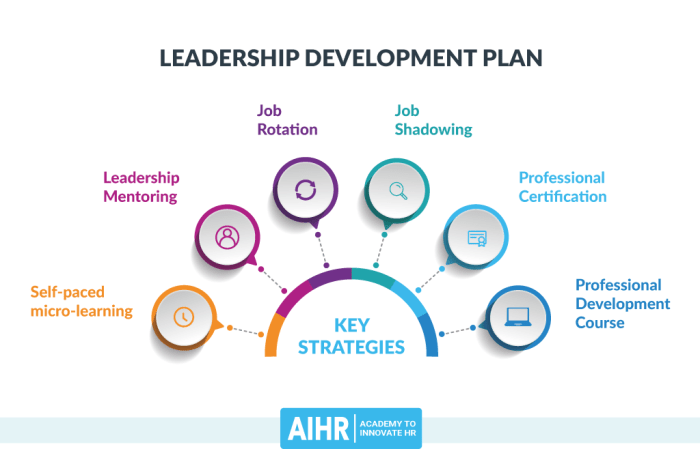
Effective leadership development programs are crucial for organizational success. However, simply implementing a program isn’t enough; a robust evaluation process is essential to understand its impact and ensure continuous improvement. This section details methods for assessing the effectiveness of these initiatives, focusing on feedback gathering, evaluation tools, and data utilization for future program enhancement.
Methods for Evaluating Leadership Development Program Effectiveness
Several methods can be used to gauge the effectiveness of leadership development initiatives. These methods offer different perspectives, providing a comprehensive understanding of the program’s impact. A multi-faceted approach, incorporating several of these methods, is generally recommended for a thorough assessment.
- Participant Feedback Surveys: Pre- and post-program surveys allow for measuring changes in knowledge, skills, and attitudes. These surveys can use Likert scales, multiple-choice questions, and open-ended questions to gather detailed feedback on various aspects of the program.
- 360-Degree Feedback: This method involves gathering feedback from multiple sources – supervisors, peers, subordinates, and even self-assessment – providing a holistic view of leadership behavior changes. The comparison of pre- and post-program 360-degree feedback reveals improvements in leadership competencies.
- Performance Metrics: Tracking key performance indicators (KPIs) such as employee engagement, team performance, project success rates, and customer satisfaction can demonstrate the program’s impact on business outcomes. Changes in these metrics after program completion provide quantifiable evidence of effectiveness.
- Return on Investment (ROI) Analysis: This method calculates the financial benefits of the leadership development program by comparing the costs of the program to the gains in productivity, reduced turnover, improved sales, or other quantifiable business benefits. A positive ROI indicates a successful investment.
- Focus Groups and Interviews: Qualitative data gathered through focus groups and individual interviews provide rich insights into participants’ experiences, perceptions, and the overall impact of the program. This in-depth feedback complements quantitative data from surveys and performance metrics.
Framework for Gathering Feedback from Participants and Stakeholders
A structured framework ensures comprehensive feedback collection. This involves defining clear objectives, identifying key stakeholders, selecting appropriate methods, and establishing a timeline for data collection and analysis.
A typical framework might include:
- Define Evaluation Goals: Clearly articulate what aspects of the program need to be evaluated (e.g., knowledge acquisition, skill development, behavioral changes, impact on business outcomes).
- Identify Stakeholders: Determine who should provide feedback (participants, managers, HR, clients).
- Select Evaluation Methods: Choose appropriate methods based on evaluation goals and resources (e.g., surveys, interviews, performance reviews).
- Develop Instruments: Create surveys, interview guides, or other tools for data collection.
- Collect Data: Implement the chosen methods at appropriate times (pre-program, post-program, follow-up).
- Analyze Data: Analyze quantitative and qualitative data to identify trends and patterns.
- Report Findings: Prepare a comprehensive report summarizing the findings and recommendations.
Examples of Effective Evaluation Tools and Techniques
Several tools and techniques can effectively measure the impact of leadership development programs.
Examples include:
- Kirkpatrick’s Four Levels of Evaluation: This model evaluates training effectiveness at four levels: Reaction (participant satisfaction), Learning (knowledge gained), Behavior (changes in on-the-job behavior), and Results (impact on organizational goals). This provides a comprehensive evaluation framework.
- Balanced Scorecard: This approach considers multiple perspectives – financial, customer, internal processes, and learning & growth – to assess the program’s impact on various aspects of the organization.
- Pre- and Post-Tests: These assess changes in knowledge and skills before and after the program, providing a quantitative measure of learning outcomes. For example, a pre-test could assess knowledge of project management principles, and a post-test could measure the same knowledge after the training.
Using Evaluation Data to Improve Future Leadership Development Programs
Evaluation data should be used to make data-driven decisions about future program iterations. This involves analyzing the strengths and weaknesses of the program, identifying areas for improvement, and making adjustments to enhance effectiveness.
For example:
- Low participant satisfaction scores might indicate a need to revise the program content, delivery methods, or learning environment.
- Limited behavioral changes might suggest the need for more practice opportunities, coaching, or reinforcement activities.
- Lack of impact on business outcomes might highlight the need to align the program’s objectives more closely with organizational goals.
Future Trends in Corporate Leadership Development Training
The landscape of corporate leadership development is undergoing a rapid transformation, driven by technological advancements, evolving workforce demographics, and a heightened focus on organizational effectiveness. Traditional methods are being augmented and, in some cases, replaced by innovative approaches that leverage technology and prioritize inclusivity to create more impactful and relevant training experiences. This evolution is crucial for organizations to cultivate leaders capable of navigating the complexities of the modern business environment.The integration of technology and a renewed emphasis on diversity, equity, and inclusion are reshaping the future of corporate leadership development.
Emerging Technologies in Leadership Development
Technological advancements are significantly impacting how leadership skills are developed and assessed. Microlearning platforms, offering bite-sized learning modules accessible anytime, anywhere, are becoming increasingly popular, catering to the diverse learning styles and busy schedules of today’s professionals. Gamification, incorporating game mechanics into learning experiences, enhances engagement and knowledge retention, transforming traditionally passive learning into active participation. Learning analytics provide data-driven insights into learner progress and program effectiveness, enabling organizations to refine their training strategies for optimal results.
For instance, a company might use learning analytics to identify areas where a specific leadership training module is underperforming and adjust the content or delivery method accordingly.
The Role of Artificial Intelligence and Virtual Reality
Artificial intelligence (AI) is poised to revolutionize leadership development. AI-powered platforms can personalize learning pathways, providing customized content and feedback based on individual learner needs and performance. AI-driven chatbots can offer immediate support and answer frequently asked questions, freeing up human trainers to focus on more complex issues. Virtual reality (VR) offers immersive simulations that allow trainees to practice leadership skills in realistic scenarios without real-world consequences.
For example, a VR simulation might place a trainee in a virtual crisis management scenario, allowing them to practice decision-making under pressure in a safe and controlled environment. This immersive approach enhances learning retention and accelerates skill development.
Diversity, Equity, and Inclusion in Leadership Development
The importance of fostering diverse, equitable, and inclusive leadership is increasingly recognized. Leadership development programs are evolving to reflect this, incorporating modules that address unconscious bias, promote inclusive leadership practices, and create a culture of belonging. Organizations are actively seeking to diversify their leadership pipelines, providing targeted support and mentorship opportunities for underrepresented groups. This involves not only recruiting diverse talent but also ensuring that training programs are culturally sensitive and cater to the diverse needs and experiences of all participants.
For example, a company might offer tailored leadership development programs for women or minority groups, focusing on specific challenges and opportunities they may face in their career paths. Such programs often incorporate mentorship opportunities and networking events to foster community and support.
Forecast of the Future Landscape of Corporate Leadership Development Training
The future of corporate leadership development will be characterized by personalization, technology integration, and a strong emphasis on diversity, equity, and inclusion. Learning will become increasingly agile and adaptable, leveraging microlearning, gamification, and AI-powered personalization to cater to individual needs and preferences. VR and augmented reality (AR) will offer immersive learning experiences, and data analytics will provide valuable insights into program effectiveness.
Leadership development will move beyond traditional classroom settings, incorporating blended learning approaches that combine online and in-person learning modalities. Organizations that prioritize continuous learning and development, embrace technological advancements, and foster inclusive cultures will be best positioned to cultivate the next generation of leaders. This will involve a shift towards more agile and adaptive training models that can quickly respond to the evolving needs of the business and the workforce.
Addressing Challenges in Corporate Leadership Development

Implementing effective leadership development programs is crucial for organizational success, yet numerous hurdles often impede progress. These challenges stem from various sources, impacting program design, implementation, and overall effectiveness. Understanding these obstacles and developing proactive strategies is paramount to fostering a culture of continuous learning and development.
Common challenges range from resource constraints and resistance to change to a lack of executive buy-in and inconsistent program evaluation. Successfully navigating these complexities requires a multi-faceted approach, encompassing strategic planning, effective communication, and a commitment to continuous improvement. Overcoming these hurdles unlocks the potential for enhanced leadership capabilities and ultimately, improved organizational performance.
Resource Constraints and Prioritization
Resource limitations, including budget restrictions, time constraints, and a shortage of skilled facilitators, frequently hinder the development and implementation of comprehensive leadership programs. Organizations may struggle to secure sufficient funding for training materials, external consultants, or dedicated program staff. Time constraints can also prevent participants from fully engaging in training activities, while a lack of qualified facilitators can compromise the quality of instruction.
Effective strategies for addressing these limitations include prioritizing leadership development initiatives based on strategic organizational goals, exploring cost-effective training methods (such as blended learning approaches), and leveraging internal expertise whenever possible. Prioritizing programs with a clear return on investment (ROI) can help justify resource allocation to leadership development. For example, a company could focus initial investment on programs directly impacting revenue-generating teams, demonstrating clear value to stakeholders.
Resistance to Change and Organizational Culture
Resistance to change, often stemming from ingrained organizational cultures or individual apprehension, presents a significant challenge. Employees may be resistant to new leadership methodologies or uncomfortable stepping outside their comfort zones. Moreover, a lack of executive sponsorship or visible support from senior leadership can undermine program effectiveness. To overcome resistance, it’s crucial to establish a clear and compelling rationale for the leadership development initiative, emphasizing its alignment with organizational goals.
Open communication, actively soliciting feedback, and addressing concerns proactively are essential. Senior leadership must actively champion the program, demonstrating commitment through participation and visible support. A successful change management strategy, including clear communication plans and ongoing feedback mechanisms, can effectively mitigate resistance and foster a culture of acceptance. For example, a company implementing a new leadership program could involve employees in the design phase, allowing them to contribute ideas and feel ownership of the process.
Creating a Culture of Continuous Learning and Development
Cultivating a culture of continuous learning and development requires a holistic approach, encompassing various initiatives. This includes establishing clear expectations for learning and development at all organizational levels, providing accessible and engaging learning opportunities, and recognizing and rewarding employees for their commitment to continuous improvement. A robust performance management system should integrate leadership development goals, tying them directly to individual and organizational performance metrics.
Regular feedback, mentoring programs, and opportunities for skill-building workshops contribute to a culture that values lifelong learning. For example, a company could establish a dedicated learning management system (LMS) providing easy access to various online courses, webinars, and resources. Regular leadership development workshops, supplemented with ongoing coaching and mentoring, would further enhance the learning experience.
Addressing Challenges in a Hypothetical Corporate Setting: A Sample Plan
Let’s consider a hypothetical medium-sized technology company experiencing challenges in leadership development. They lack a structured program, face budget constraints, and encounter resistance from some mid-level managers.
Phase 1: Assessment and Needs Analysis: Conduct a thorough assessment of current leadership capabilities and identify specific skill gaps. This involves surveys, interviews, and performance reviews. A detailed cost-benefit analysis will be conducted to justify resource allocation.
Phase 2: Program Design and Implementation: Design a blended learning program combining online modules, workshops, and mentoring. The program will focus on critical leadership competencies identified in the needs analysis. Pilot the program with a select group of employees to gather feedback and make improvements before full-scale implementation. Secure executive sponsorship and communication to gain buy-in.
Phase 3: Evaluation and Continuous Improvement: Establish clear metrics to measure program effectiveness, such as employee feedback, performance improvements, and return on investment. Regularly review and update the program based on feedback and evolving organizational needs. Regular communication and ongoing support from leadership will be provided to maintain momentum and address any concerns.
Ultimately, investing in corporate leadership development training is an investment in the future of the organization. By fostering strong leadership, companies can cultivate a culture of innovation, improve employee engagement, and achieve sustainable growth. A well-structured program, aligned with organizational goals and measured effectively, is key to maximizing the return on this vital investment. The journey to developing exceptional leaders is a continuous process, requiring ongoing evaluation, adaptation, and a commitment to fostering a culture of continuous learning.
User Queries
What is the ideal duration for a corporate leadership development program?
The ideal duration varies depending on the program’s goals and the participants’ experience levels. Programs can range from short, focused workshops to multi-year development initiatives.
How can I measure the success of my leadership development program?
Success can be measured through various metrics, including improved employee performance, increased engagement, higher retention rates, and demonstrable improvements in organizational outcomes.
How do I address resistance to leadership development training within my organization?
Addressing resistance requires clear communication of the program’s value, addressing concerns proactively, and securing buy-in from key stakeholders. Demonstrating a clear ROI can be highly effective.
What are the key differences between in-person and online leadership training?
In-person training offers greater opportunities for networking and interactive learning, while online training provides flexibility and scalability. A blended approach often combines the benefits of both.

